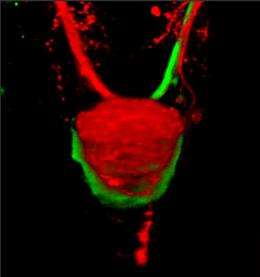Fear responses of zebrafish controlled by brain structures of previously unknown function

A brain structure called the habenula is crucial for modifications of fear responses in zebrafish, according to a new study by researchers from the RIKEN Brain Science Institute, Wako. The zebrafish dorsal habenula is subdivided into two regions, each connected to different brain structures, but the function of each, and the significance of their connections, was unclear.
Hitoshi Okamoto and his colleagues used fluorescent dyes to trace the neural pathways from the interpeduncular nucleus (IPN), which receives connections from the dorsal habenula region. They found that the dorsal IPN projects to midbrain structures called the dorsal raphe nucleus and griseum centrale. The corresponding structures in the mammalian brain have been implicated in responses to fear and stress, suggesting that the habenula–IPN pathway in zebrafish is also involved in these responses.
To investigate this, the researchers created transgenic zebrafish expressing tetanus toxin in the lateral subnucleus of the dorsal habenula. The toxin blocks neurotransmission, preventing neurons in that region from sending signals.
The transgenic fish were then subjected to an established fear conditioning task, in which a red light is repeatedly paired with an electric shock. Normally, the fish learn to associate the two stimuli, and become agitated—recognized by an increase in the frequency of turning—in the presence of the light alone. However, when the transgenic fish encountered the red light after the fear conditioning task, they froze rather than escaping. Okamoto and colleagues observed these differences between the transgenic fish and controls during the fear conditioning task. Both froze the first time they encountered the red light; the controls started to become agitated the second time, but the transgenic fish continued to freeze.
The exploratory behavior of the transgenic fish was no different from that of the controls, showing that their responses to fear conditioning were not due to abnormal sensory or motor function. Instead, the results suggest to the researchers that the transgenic fish cannot modify their fear response after new experiences. They therefore conclude that experience-dependent modifications of fear responses are controlled by the neurons in the lateral subnucleus of the dorsal habenula in the zebrafish.
“We would like to know whether the same regulation mechanism works in mammals, including humans,” says Okamoto, “and would also like to extend our research to reveal the functions of the other parts of the habenula.”
More information: Agetsuma, M., et al. The habenula is crucial for experience-dependent modification of fear responses in zebrafish. Nature Neuroscience 13, 1354–1356 (2010). Read the full article here: www.nature.com/neuro/journal/v … n11/abs/nn.2654.html .















